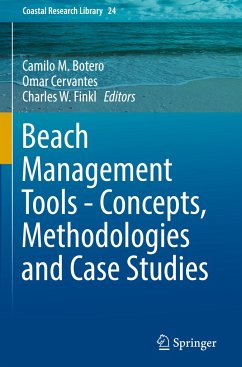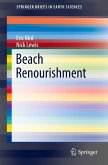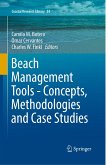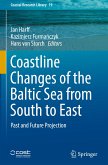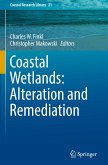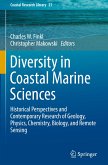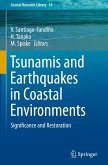Beach Management Tools - Concepts, Methodologies and Case Studies
Herausgegeben:Botero, Camilo M.; Cervantes, Omar; Finkl, Charles W.
Beach Management Tools - Concepts, Methodologies and Case Studies
Herausgegeben:Botero, Camilo M.; Cervantes, Omar; Finkl, Charles W.
- Gebundenes Buch
- Merkliste
- Auf die Merkliste
- Bewerten Bewerten
- Teilen
- Produkt teilen
- Produkterinnerung
- Produkterinnerung
This book provides an overview of beach management tools, including carrying capacity, beach nourishment, environmental and tourism awards (like Blue Flag or others), bathing water quality, zoning, beach typologies, quality index, user's perception, interdisciplinary beach monitoring, coastal legislation, shore protection, social and economic indicators, ecosystem services, and coastal governance (applied in beach case studies). Beaches are one of the most intensely used coastal ecosystems and are responsible for more than half of all global tourism revenues, and as such the book introduces a…mehr
Andere Kunden interessierten sich auch für
![Brazilian Beach Systems Brazilian Beach Systems]() Brazilian Beach Systems111,99 €
Brazilian Beach Systems111,99 €![Beach Renourishment Beach Renourishment]() Eric BirdBeach Renourishment37,99 €
Eric BirdBeach Renourishment37,99 €![Beach Management Tools - Concepts, Methodologies and Case Studies Beach Management Tools - Concepts, Methodologies and Case Studies]() Beach Management Tools - Concepts, Methodologies and Case Studies206,99 €
Beach Management Tools - Concepts, Methodologies and Case Studies206,99 €![Coastline Changes of the Baltic Sea from South to East Coastline Changes of the Baltic Sea from South to East]() Coastline Changes of the Baltic Sea from South to East74,99 €
Coastline Changes of the Baltic Sea from South to East74,99 €![Coastal Wetlands: Alteration and Remediation Coastal Wetlands: Alteration and Remediation]() Coastal Wetlands: Alteration and Remediation170,99 €
Coastal Wetlands: Alteration and Remediation170,99 €![Diversity in Coastal Marine Sciences Diversity in Coastal Marine Sciences]() Diversity in Coastal Marine Sciences148,99 €
Diversity in Coastal Marine Sciences148,99 €![Tsunamis and Earthquakes in Coastal Environments Tsunamis and Earthquakes in Coastal Environments]() Tsunamis and Earthquakes in Coastal Environments74,99 €
Tsunamis and Earthquakes in Coastal Environments74,99 €-
-
-
This book provides an overview of beach management tools, including carrying capacity, beach nourishment, environmental and tourism awards (like Blue Flag or others), bathing water quality, zoning, beach typologies, quality index, user's perception, interdisciplinary beach monitoring, coastal legislation, shore protection, social and economic indicators, ecosystem services, and coastal governance (applied in beach case studies).
Beaches are one of the most intensely used coastal ecosystems and are responsible for more than half of all global tourism revenues, and as such the book introduces a wide range of state-of-the-art tools that can be used to deal with a variety of beach challenges. Each chapter features specific types of tools that can be applied to advantage in beach management practices. With examples of local and regional case studies from around the globe, this is a valuable resource for anyone involved in beach management.
Hinweis: Dieser Artikel kann nur an eine deutsche Lieferadresse ausgeliefert werden.
Beaches are one of the most intensely used coastal ecosystems and are responsible for more than half of all global tourism revenues, and as such the book introduces a wide range of state-of-the-art tools that can be used to deal with a variety of beach challenges. Each chapter features specific types of tools that can be applied to advantage in beach management practices. With examples of local and regional case studies from around the globe, this is a valuable resource for anyone involved in beach management.
Hinweis: Dieser Artikel kann nur an eine deutsche Lieferadresse ausgeliefert werden.
Produktdetails
- Produktdetails
- Coastal Research Library 24
- Verlag: Springer / Springer International Publishing / Springer, Berlin
- Artikelnr. des Verlages: 978-3-319-58303-7
- 1st ed. 2018
- Seitenzahl: 984
- Erscheinungstermin: 15. Dezember 2017
- Englisch
- Abmessung: 241mm x 160mm x 55mm
- Gewicht: 1764g
- ISBN-13: 9783319583037
- ISBN-10: 3319583034
- Artikelnr.: 48009947
- Herstellerkennzeichnung
- Books on Demand GmbH
- In de Tarpen 42
- 22848 Norderstedt
- info@bod.de
- 040 53433511
- Coastal Research Library 24
- Verlag: Springer / Springer International Publishing / Springer, Berlin
- Artikelnr. des Verlages: 978-3-319-58303-7
- 1st ed. 2018
- Seitenzahl: 984
- Erscheinungstermin: 15. Dezember 2017
- Englisch
- Abmessung: 241mm x 160mm x 55mm
- Gewicht: 1764g
- ISBN-13: 9783319583037
- ISBN-10: 3319583034
- Artikelnr.: 48009947
- Herstellerkennzeichnung
- Books on Demand GmbH
- In de Tarpen 42
- 22848 Norderstedt
- info@bod.de
- 040 53433511
Camilo-Mateo Botero Saltaren Expert in integrated coastal management and tourist beaches. European PhD in Water and Coastal Management (Spain), European Master in Water and Coastal Management (Portugal), Master in Ports and Coastal Engineering (Spain), postgraduate course in Public Management (Colombia), UNESCO expert in Tsunami Warning Systems (Hawaii, EEUU), PNUD expert in Multilateral Environmental Agreements (Grenada) European Expert in Marine Spatial Planning (France) and Environmental and Sanitary Engineer (Colombia). He has been professor in Colombia, Ecuador, Cuba, Argentina, Brasil, Puerto Rico and Uruguay in topics such as beach management, environmental impact assessment, coastal management, environmental management and research methods. He is researcher in marine topics since 1996, focusing last years in beach certification schemes and beach environmental quality. He become to several academic networks, such as the Beach Management and Certification IberoamericanNetwork - PROPLAYAS and the Integrated Coastal Management Iberoamerican Network - IBERMAR. Moreover, he is director of the Coastal Systems Research Group in Colombia, researcher in Universidad de La Costa (Colombia), member of editorial board of 'Revista COSTAS' of UNESCO and reviewer of the Ocean and Coastal Management Journal (Elsevier). Author of more than 50 publications, including books, scientific articles and dissemination. Lecturer in over 60 opportunities and advisory over 20 undergraduate and master's thesis. He is fluent in English language and communication skills in Italian and Portuguese. Omar Darío Cervantes Rosas Dr. Omar Cervantes is specialist in Coastal Zone and Beach Management. He has a master and a PhD in Coastal Oceanography and postgraduate courses in The professionalization of NGOs. Member of national system of researchers en Mexico since 2013. He participated in two short stays in Ceará and Para Brazilian Federal Universities in beach management topics. He is a technical expert in Beach certification and Ecoturism standards of The Mexican Accreditation Body (EMA). He worked to environmental consulting companies (2002-2011) as the project manager of environmental baseline studies in tourism coastal projects, in restoration of coastal environments and environmental supervision. He is a research professor in a Bachelor career of Marine Sciences (Oceanology) and in the Master program of Marine Sciences of the Faculty of Marine Sciences (University of Colima, México). He teaches lectures on Integrated Coastal Zone Management (ICZM), Coastal Ecology, Marine Pollution, Environmental Economics, Risk Management, Coastal Policy Analysis and others topics. He has been instructor in short courses about Beach Management in Brazil, Colombia and Uruguay. Since 2001 he has been an environmental consultant on topics such as Environmental Impact and Environmental Site assessment, focusing his last projects in beachmanagement topics; rip currents and beach risks, environmental valuation, zonification and certification or ecolabels. He published articles at Ocean and Coastal Management, Journal of Coastal Research and Environmental Management Journals. Advisory in undergraduate, masters and PhD¿s thesis. He have communication skills in English and Portuguese language. He has been reviewer of scientific projects for the Council on Science and Technology of Uruguay and México. Now he is a member of scientific networks such as Iberoamerican network of Beach management Proplayas and Integrated Coastal Management (IBERMAR).
1. A Decision Making (DEMA) tool to be used in Ecosystem-Based Management System (EBMS) applications. Rafael Sardá, Juan Pablo Lozoya Azcárate2. Active management of microbiological pollution risks in bathing waters: tools and future perspective. Carlos J. A. Campos3. Affectation of harmful algal blooms in the environment, public health and the development of productive activities in the coastal zone of Mexico: case study of the lack of governance for the solution of this problem. Olivos Ortiz A., O.D. Cervantes-Rosas, S.I. Quijano-Scheggia, A. Pérez-Moralez, G.M. Verduzco-Zapata.4. An overview of Integrated and interdisciplinary approaches to Beach and Coastal. Francisco Gutierres, Pedro Gomes, Jorge Rocha, Ana Cláudia Teodoro & Carlos Neto5. Analysis of Blue Flag Beaches compared with Natural Beaches in the Balearic Islands and Canary Islands, Spain. Francesc Xavier Roig-Munar, Carolina Peña-Alonso y Pablo Fraile-Jurado6. Assessing hotspots to storm-induced hazards in the Catalan coast. Where are my sensitive areas? José A. Jiménez, Caridad Ballesteros, Marta Argemi7. Assessing shoreline change rates in Mediterranean beaches. A comprehensive comparison between datum-based and proxy-based shoreline extraction approaches. Fernando J. Aguilar, Ismael Fernández, Manuel A. Aguilar, Andres M. García-Lorca8. Assessment of beach sand and its associated health effects: an example from port dickson beaches (Malaysia). Sarva Mangala Praveena, Siti Shafiqa Shamira, Ahmad Zaharin Aris9. Assessment of the Beaches of the Dominican Republic by useful Management Variables. Francesc Xavier Roig Munar, José Ángel Martin Prieto, Oliver Olivo Batista y Antonio Rodríguez-Perea10. Beach carrying capacity estimations using HR satellite imagery - a tool to define beach use areas. Zenaida Diogo, Cristina Lira, Tanya Silveira11. Beach Carrying Capacity: The importance of a concept poorly understood. Carlos Pereira da Silva, Catarina Fonseca & Ricardo Nogueira Mendes12. Beach Ecosystem-based Adaptation. Joanna Ellison 13. Beach litter characteristics along the Gibraltar Strait: implications for coastal zone management. D. Nachite, A. Macias, F. Meziane, G. Anfuso14. Beach safety management. G. Anfuso, G.D. Pezzini, E. Pranzini15. Beaches of the southern baltic sea, Leszek Kaszubowski16. Coastal sand dune dynamic and evolutive trend in a headland bay beach system in semi arid Chile: The case of Punta de Choros, Coquimbo. Maria Victoria Soto; Arriagada, J.; Benavente, N.; Cabello, M.; Magallanes, V y Rojas, I. 17. Comparative Analysis of the Management Process and Governance of beaches between Brazil and Uruguay. Luidgi Marchese, Marcus Pollete18. Counting beach visitors: Tools, methods and management applications. Damian Morgan19. Coupled Human-Nature Tools for Beach Management. Ayse Karanci, Liliana Velasquez-Montoya, Juan F. Paniagua-Arroyave, Peter N. Adams, Margery F. Overton20. Drowning risk perception in coastal areas: Elements for building a methodology for prevention. Alfredo Jaramillo-Vélez, Hernán Alfredo Nieto Uribe, Dina Vanessa Gómez Rave21. Ecosystem management tools to study natural habitats as wave energy dissipation structures and coastal protection mechanisms. Juan David Osorio-Cano, Andrés F. Osorio22. Environmental and health risk by the presence of parasites in the sand of cartagena beaches. Jorge Iván Blanco Herrera, Betsy Paola González Arrunategui, Ganiveth Manjarrez Paba23. Florida and US East Coast Beach Change Metrics Derived from LiDAR Data Utilizing ArcGIS Python Based Tools. Quin Robertson, Zhifei Dong, Keqi Zhang and Jennifer Wozencraft24. Identification of Storm Surge Vulnerable Areas in Bay of Manzanillo, Colima, México. Galicia-Pérez Marco Antonio, Sámano-Rodríguez Clara A., Torres-Orozco Ernesto, Patiño-Barragán Manuel25. Integrating beach user and local community perceptions in beach management. Elisabet Roca, Míriam Villares26. Landfilling of coastal wetlands in Yucatan, Mexico: a multidisciplinary analysis. Ulsia Urrea27. Environmental services as a tool for negotiating usage in the coastal ecoregions of the sand dunes in Baja California, Mexico. Natalia Rodríguez-Revelo, Ileana Espejel, Concepción Arredondo, Pedro Peña-Garcillán, Alejandra Sánchez-Vázquez, Lina Ojeda Revah28. Management for multipurpose use on sheltered beaches: conceptual framework for conservation and recreation over an ecological basis. Minerva Torres, Adela Figueroa, Rosario Chávez, Omar Defeo Gorozpe, Ismael Mariño, Juan Carlos Alcerreca, Martha Moctezuma29. Microscale governance and temporal regulations in beach Management. Isaac Azuz-Adeath, Norma Patricia Muñoz-Sevilla, Evelia Rivera-Arriaga, Lidia Silva-Íñiguez, Oscar Arizpe-Covarrubias, Omar Cervantes, Gisela García-Morales, José Alfredo Arreola-Lizárraga, Alfredo Ortega-Rubio, Laura Martínez-Ríos and Alejandra Cortés-Ruíz30. Nautical Recreational and Beach Tourism Service Providers (NRBTSP) at Gaviotas beach in Mazatlán, Sinaloa (Mexico). Marcela Contreras, Juan Pablo Mariño31. Overall response to deep sea impact on Colima´s beaches. Raymundo Padilla32. Preserving sand quality in beach nourishment. G. Anfuso, E. Pranzini33. Privatization of the Mexican Coast, the case of the municipality of Solidarity (municipio de Solidaridad), Quintana Roo: correspondence between the work of public administration and development of everyday life practices. Ulsia Urrea34. Recreational carrying capacity assessment for beach management, with examples from southern Mozambique. Daniel Augusta Zacarias35. Recreational preferences of estonian shore types and willingness to pay in comparison. Mart Reimann, Üllas Ehrlich, Hannes Tõnisson36. Rip currents in Costa Rica: drowning statistics, research and future developments. Isabel Arozarena, Alejandro Gutierréz37. Sandy beach preservation and recreation: actions for adaptation to the legislation. Luana Portz38. Status of the Coastline of Puerto Rico. Maritza Barreto39. Sustainable Coastal Zone Management Strategies for Unconsolidated Deltaic Odisha, the Northern Part of East Indian Coast. Nilay Kanti Barman40. Temporal space behavior of three environmental quality determinants from touristic beaches in cartagena, Colombia. Juan Carlos Valdelamar Villegas, Kevin Andrade Quintero, Claudia Díaz Mendoza, Ganiveth Manjarrez Paba41. The Morphodynamics behaviour of a cross-shore sandbar in a microtidal environment. João Wagner Alencar Castro42. Use and perception on beach restoration projects in Yucatán peninsula: technical or culture issues? Nuno Simoes, Alfonso Solís, María Suárez43. User's perception of beach characteristics and management in summer and autumn seasons: the case of Gran Canaria Islands (Spain). Carolina Peña Alonso, Eduard Ariza Solé, Luis Hernández Calvento44. Users' data support the case for differential beach management in South Africa. Serena Lucrezia, Linda-Louise Geldenhuys, Peet Van der Merwe, Melville Saayman45. Using drones to evaluate sand volumen in the "La Lagunita" dune field, Ensenada, México. Rigoberto Guardado France, Napoleón Gudiño Elizondo, Oswaldo Carrillo Rodríguez, Miguel Agustín Téllez Duarte, Alejandro Hinojosa Corona
1. A Decision Making (DEMA) tool to be used in Ecosystem-Based Management System (EBMS) applications. Rafael Sardá, Juan Pablo Lozoya Azcárate2. Active management of microbiological pollution risks in bathing waters: tools and future perspective. Carlos J. A. Campos3. Affectation of harmful algal blooms in the environment, public health and the development of productive activities in the coastal zone of Mexico: case study of the lack of governance for the solution of this problem. Olivos Ortiz A., O.D. Cervantes-Rosas, S.I. Quijano-Scheggia, A. Pérez-Moralez, G.M. Verduzco-Zapata.4. An overview of Integrated and interdisciplinary approaches to Beach and Coastal. Francisco Gutierres, Pedro Gomes, Jorge Rocha, Ana Cláudia Teodoro & Carlos Neto5. Analysis of Blue Flag Beaches compared with Natural Beaches in the Balearic Islands and Canary Islands, Spain. Francesc Xavier Roig-Munar, Carolina Peña-Alonso y Pablo Fraile-Jurado6. Assessing hotspots to storm-induced hazards in the Catalan coast. Where are my sensitive areas? José A. Jiménez, Caridad Ballesteros, Marta Argemi7. Assessing shoreline change rates in Mediterranean beaches. A comprehensive comparison between datum-based and proxy-based shoreline extraction approaches. Fernando J. Aguilar, Ismael Fernández, Manuel A. Aguilar, Andres M. García-Lorca8. Assessment of beach sand and its associated health effects: an example from port dickson beaches (Malaysia). Sarva Mangala Praveena, Siti Shafiqa Shamira, Ahmad Zaharin Aris9. Assessment of the Beaches of the Dominican Republic by useful Management Variables. Francesc Xavier Roig Munar, José Ángel Martin Prieto, Oliver Olivo Batista y Antonio Rodríguez-Perea10. Beach carrying capacity estimations using HR satellite imagery - a tool to define beach use areas. Zenaida Diogo, Cristina Lira, Tanya Silveira11. Beach Carrying Capacity: The importance of a concept poorly understood. Carlos Pereira da Silva, Catarina Fonseca & Ricardo Nogueira Mendes12. Beach Ecosystem-based Adaptation. Joanna Ellison 13. Beach litter characteristics along the Gibraltar Strait: implications for coastal zone management. D. Nachite, A. Macias, F. Meziane, G. Anfuso14. Beach safety management. G. Anfuso, G.D. Pezzini, E. Pranzini15. Beaches of the southern baltic sea, Leszek Kaszubowski16. Coastal sand dune dynamic and evolutive trend in a headland bay beach system in semi arid Chile: The case of Punta de Choros, Coquimbo. Maria Victoria Soto; Arriagada, J.; Benavente, N.; Cabello, M.; Magallanes, V y Rojas, I. 17. Comparative Analysis of the Management Process and Governance of beaches between Brazil and Uruguay. Luidgi Marchese, Marcus Pollete18. Counting beach visitors: Tools, methods and management applications. Damian Morgan19. Coupled Human-Nature Tools for Beach Management. Ayse Karanci, Liliana Velasquez-Montoya, Juan F. Paniagua-Arroyave, Peter N. Adams, Margery F. Overton20. Drowning risk perception in coastal areas: Elements for building a methodology for prevention. Alfredo Jaramillo-Vélez, Hernán Alfredo Nieto Uribe, Dina Vanessa Gómez Rave21. Ecosystem management tools to study natural habitats as wave energy dissipation structures and coastal protection mechanisms. Juan David Osorio-Cano, Andrés F. Osorio22. Environmental and health risk by the presence of parasites in the sand of cartagena beaches. Jorge Iván Blanco Herrera, Betsy Paola González Arrunategui, Ganiveth Manjarrez Paba23. Florida and US East Coast Beach Change Metrics Derived from LiDAR Data Utilizing ArcGIS Python Based Tools. Quin Robertson, Zhifei Dong, Keqi Zhang and Jennifer Wozencraft24. Identification of Storm Surge Vulnerable Areas in Bay of Manzanillo, Colima, México. Galicia-Pérez Marco Antonio, Sámano-Rodríguez Clara A., Torres-Orozco Ernesto, Patiño-Barragán Manuel25. Integrating beach user and local community perceptions in beach management. Elisabet Roca, Míriam Villares26. Landfilling of coastal wetlands in Yucatan, Mexico: a multidisciplinary analysis. Ulsia Urrea27. Environmental services as a tool for negotiating usage in the coastal ecoregions of the sand dunes in Baja California, Mexico. Natalia Rodríguez-Revelo, Ileana Espejel, Concepción Arredondo, Pedro Peña-Garcillán, Alejandra Sánchez-Vázquez, Lina Ojeda Revah28. Management for multipurpose use on sheltered beaches: conceptual framework for conservation and recreation over an ecological basis. Minerva Torres, Adela Figueroa, Rosario Chávez, Omar Defeo Gorozpe, Ismael Mariño, Juan Carlos Alcerreca, Martha Moctezuma29. Microscale governance and temporal regulations in beach Management. Isaac Azuz-Adeath, Norma Patricia Muñoz-Sevilla, Evelia Rivera-Arriaga, Lidia Silva-Íñiguez, Oscar Arizpe-Covarrubias, Omar Cervantes, Gisela García-Morales, José Alfredo Arreola-Lizárraga, Alfredo Ortega-Rubio, Laura Martínez-Ríos and Alejandra Cortés-Ruíz30. Nautical Recreational and Beach Tourism Service Providers (NRBTSP) at Gaviotas beach in Mazatlán, Sinaloa (Mexico). Marcela Contreras, Juan Pablo Mariño31. Overall response to deep sea impact on Colima´s beaches. Raymundo Padilla32. Preserving sand quality in beach nourishment. G. Anfuso, E. Pranzini33. Privatization of the Mexican Coast, the case of the municipality of Solidarity (municipio de Solidaridad), Quintana Roo: correspondence between the work of public administration and development of everyday life practices. Ulsia Urrea34. Recreational carrying capacity assessment for beach management, with examples from southern Mozambique. Daniel Augusta Zacarias35. Recreational preferences of estonian shore types and willingness to pay in comparison. Mart Reimann, Üllas Ehrlich, Hannes Tõnisson36. Rip currents in Costa Rica: drowning statistics, research and future developments. Isabel Arozarena, Alejandro Gutierréz37. Sandy beach preservation and recreation: actions for adaptation to the legislation. Luana Portz38. Status of the Coastline of Puerto Rico. Maritza Barreto39. Sustainable Coastal Zone Management Strategies for Unconsolidated Deltaic Odisha, the Northern Part of East Indian Coast. Nilay Kanti Barman40. Temporal space behavior of three environmental quality determinants from touristic beaches in cartagena, Colombia. Juan Carlos Valdelamar Villegas, Kevin Andrade Quintero, Claudia Díaz Mendoza, Ganiveth Manjarrez Paba41. The Morphodynamics behaviour of a cross-shore sandbar in a microtidal environment. João Wagner Alencar Castro42. Use and perception on beach restoration projects in Yucatán peninsula: technical or culture issues? Nuno Simoes, Alfonso Solís, María Suárez43. User's perception of beach characteristics and management in summer and autumn seasons: the case of Gran Canaria Islands (Spain). Carolina Peña Alonso, Eduard Ariza Solé, Luis Hernández Calvento44. Users' data support the case for differential beach management in South Africa. Serena Lucrezia, Linda-Louise Geldenhuys, Peet Van der Merwe, Melville Saayman45. Using drones to evaluate sand volumen in the "La Lagunita" dune field, Ensenada, México. Rigoberto Guardado France, Napoleón Gudiño Elizondo, Oswaldo Carrillo Rodríguez, Miguel Agustín Téllez Duarte, Alejandro Hinojosa Corona

